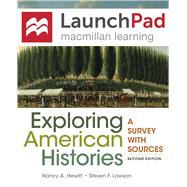Exploring American Histories opens an entirely new window into the many histories of the nation’s past. It integrates an unprecedented number of primary sources—both written and visual—in a unique building blocks approach that enables students to hone their analysis skills while they actively learn the fundamental concepts of American history. By weaving sources into the story and culminating in multidocument projects around a single topic at the end of each chapter, the book brings history to life while helping students understand how sources form the basis of historical narratives and how to think critically about them.
The possibilities for active learning and assessment expand with the LaunchPad e-book and course space which adds a wealth of time-saving teaching and learning tools at instructors’ fingertips. LaunchPad comes with LearningCurve, an adaptive and automatically graded learning tool that students love to use and that, when assigned, ensures students come to class prepared. Easy to integrate into your campus LMS, and featuring additional primary sources, summative quizzing, videos, new autograded source-based questions, and new autograded exercises that guide students to use sources to build an argument, LaunchPad provides an easy and fun way to help students learn about American history while helping them make progress toward learning outcomes.








